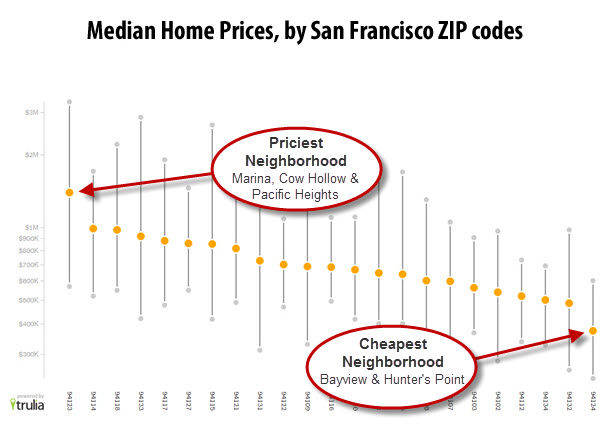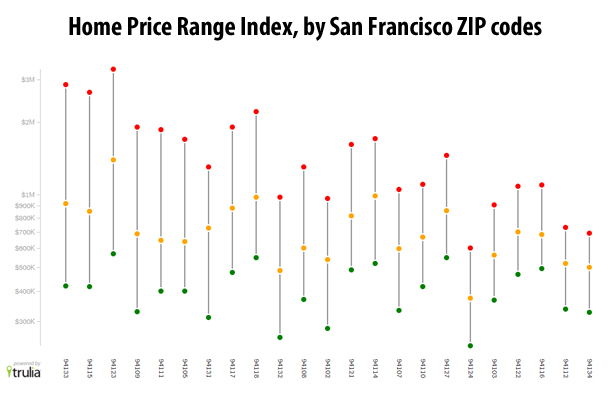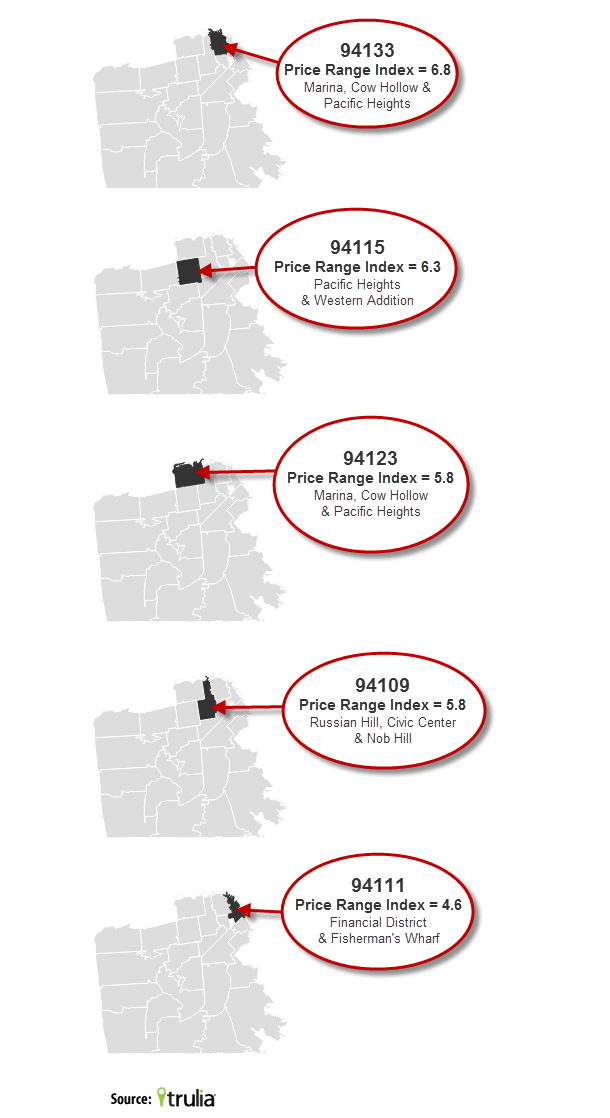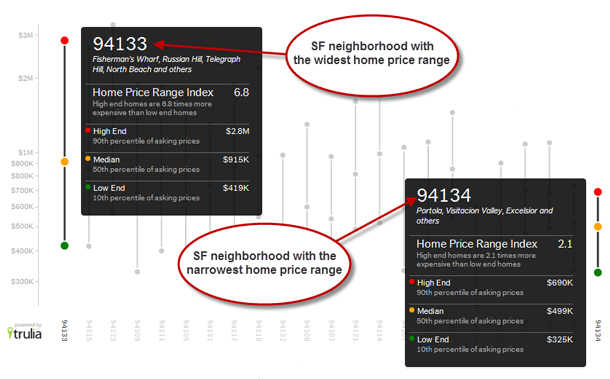Ever wonder where the other half lives? (We do, though it’s mainly because we love to gawk at the homes of the rich on our sister site, Luxe Living). But just how far do you have to look to find mega mansions like this $38M hilltop mansion on Billionaire’s Row (aka, where the most expensive homes in San Francisco, between Lyon and Divisadero on Broadway Street, are located)?

Then there’s an even bigger, more relevant question: is it possible to find a home in that same neighborhood at a non-billionaire price? In this case, the answer is “yes.” A few blocks away, but still in the same ZIP code as the homes on Billionaire’s Row, is this relatively affordable $300K 2-bedroom condo.

The bottom line is—in neighborhoods like this, with homes for sale at a wide range of price points, you’ll have a better chance of buying a place near the upper crust and enjoying the same ritzy neighborhood amenities (such as schools, shops, parks, etc.) that the rich enjoy, even if you can’t afford the mansion. Meanwhile, in neighborhoods where home prices are very similar, you’ll find either all expensive homes or all cheap homes, since the mix of homes usually has a pretty big impact on the vibe of a neighborhood.
So to figure out which neighborhood is which (when it comes to home price ranges), we’re going to do a monthly spotlight on the range of asking prices within neighborhoods in different major cities across the country. And to kick things off, we’re going to start with an inside look at our hometown of San Francisco.

What we found is that the most expensive SF ZIP code (based on median asking price) is 94123, which includes the Marina, Cow Hollow and Pacific Heights. Meanwhile, the cheapest ZIP in SF is 94124, which includes Bayview and Hunter’s Point. To put this into perspective, the median home in Marina/Cow Hollow/Pacific Heights is 3.5x more expensive than the median home in Bayview/Hunter’s Point.

But what’s really interesting is what’s happening within neighborhoods. We know that the Marina/Cow Hollow/Pacific Heights is the most expensive neighborhood in SF, but is it only made up of mansions? Can someone who’s not working at Facebook or Instagram afford to live in that neighborhood and take advantage of the same amenities that the millionaires have access to? That’s the burning question when it comes to the range of home prices in different neighborhoods—is there a selection of homes for sale at different price points? Or is the cost of buying a home in the neighborhood the same for most homes?
To figure out the range of asking home prices within different neighborhoods, we took all the for-sale homes listed on Trulia.com in 2011 in each SF ZIP code and identified the 90th percentile asking price (aka the price of a home that’s MORE expensive than 90% of the other homes in its ZIP code) and the 10th percentile asking price (aka the price of the home that’s MORE expensive than only 10% of the other homes in its ZIP code).
We then calculated the Home Price Range Index by dividing the price of the 90th percentile home by the price of the 10th percentile home. Here’s an example of the calculation for the visual learners out there:
Neighborhood: Hundred Acre Woods
(where Christopher Robin and Winnie-the-Pooh play)
90th Percentile Asking Price: $1 million (aka Rabbit’s Home)
10th Percentile Asking Price: $100,000 (aka Eeyore’s Home)
Home Price Range Index = $1,000,000 / $100,000 = 10
Interpretation: Rabbit’s home is 10x more expensive than Eeyore’s home
So since 94123 has a Home Price Range Index of 5.8, this means that a 90th percentile home in that neighborhood is 5.8 times more expensive than the 10th percentile home.
In that same vein, a neighborhood with a higher Home Price Range Index means that there is more home price variation than a neighborhood with a lower Home Price Range Index. Thus, 94133 (HPR Index =6.8) has a bigger range in home prices than 94134 (HPR Index = 2.1).
After crunching all the numbers, we created an interactive infographic to show which neighborhoods have a wider spread when it comes to asking home prices. Here’s what we found.

The largest Home Price Indices in San Francisco are in 94133 (which includes Fisherman’s Wharf, Russian Hill and North Beach) where the most expensive homes are 6.8x more expensive than the cheapest homes. So if you’re set on living in this area, but aren’t willing to shell out $2.8M for a high-end home, there are still plenty of homes under $1M that will allow you be a part of this neighborhood and be kinder to your pocketbook.
If you look at the top five ZIPs with the biggest ranges of asking home prices, you’ll notice that they’re all in the northern part of the city (check out the maps below).

Since the housing stock in these parts are older and denser, you’ll probably have more luck finding a “bargain” fixer-upper (relatively speaking) alongside a multi-million dollar pad.
Home prices are more uniform in places that are farther out from the center of the city and more recently built, like Portola, Excelsior and the Sunset. As such, it’s not surprising that the narrowest range of prices is found in 94143 (Portola, Visitacion Valley and Excelsior) where the priciest homes are only 2.1x more expensive than the cheapest homes. If you live in one of these neighborhoods, it’s likely that your home’s asking price will be pretty similar to your neighbors’.

So, what does this mean if you’re looking to move? Long story short, it’s just another reason why “location! location! location!” needs to be your house hunting mantra. Because for $600k, you could have one of the nicest homes in Bayview/Hunter’s Point, but you could also have one of the cheapest homes in the Marina/Cow Hollow/Pac Heights. Choose wisely. The decision is yours and yours alone—would you rather live in a neighborhood where all the homes are more or less equally priced, or would you rather live among a mix of mansions and modest homes?
What do you think of our little analysis, and, more importantly, where we should head next?

